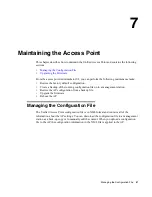
70 © 2001-2008 D-Link Corporation. All Rights Reserved.
D-Link Unified Access Point Administrator’s Guide
802.11e and WMM Standards Support
QoS
describes a range of technologies for controlling data streams on shared network
connections. The
IEEE
802.11e
task group is in the process of defining a QoS standard for
transmission quality and availability of service on wireless networks. QoS is designed to
provide better network service by minimizing network congestion; limiting
Jitter
,
Latency
,
and
Packet Loss
; supporting dedicated bandwidth for time-sensitive or mission critical
applications, and prioritizing wireless traffic for channel access.
As with all IEEE
802.11
working group standards, the goal is to provide a standard way of
implementing QoS features so that components from different companies are interoperable.
The Unified Access Point provides QoS based on the Wireless Multimedia (
WMM
)
specification, which implements a subset of
802.11e
features.
Both access points and wireless clients (laptops, consumer electronics products) can be
WMM-enabled by the Wi-Fi Alliance.
QoS Queues and Parameters to Coordinate Traffic Flow
Configuring QoS options on the Unified Access Point consists of setting parameters on
existing queues for different types of wireless traffic. You can configure different minimum
and maximum wait times for the transmission of packets in each queue based on the
requirements of the media being sent. Queues automatically provide minimum transmission
delay for Voice, Video, multimedia, and mission critical applications, and rely on best-effort
parameters for traditional IP data.
For example, time-sensitive Voice, Video, and multimedia are given effectively higher priority
for transmission (lower wait times for channel access), while other applications and traditional
IP data which are less time-sensitive but often more data-intensive are expected to tolerate
longer wait times.
The Unified Access Point implements QoS based on the IEEE Wireless Multimedia (WMM)
standard. A Linux-based queuing class is used to tag packets and establish multiple queues.
The queues provided offer built-in prioritization and routing based on the type of data being
transmitted.
The Administration UI provides a way for you to configure parameters on the queues.
QoS Queues and Diff-Serve Code Points (DSCP) on Packets
QoS on the Unified Access Point leverages
WMM
information in the IP packet header related
to Diff-Serv Code Point (DSCP). Every IP packet sent over the network includes a DSCP field
in the header that indicates how the data should be prioritized and transmitted over the
network. The DSCP field consists of a 6 bit value defined by the local administration. For
WMM, the Wi-Fi Alliance suggests a particular mapping for DSCP values
The access point examines the DSCP field in the headers of all packets that pass through the
AP. Based on the value in a packet’s DSCP field, the AP prioritizes the packet for transmission
by assigning it to one of the queues. This process occurs automatically, regardless of whether
you deliberately configure QoS or not.
















































